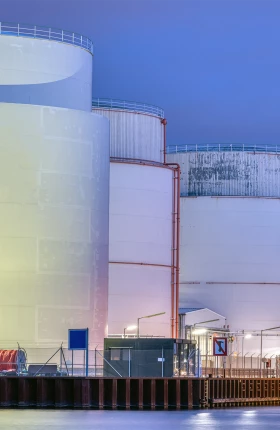The widespread adoption of carbon capture technology is crucial for meeting the Paris Agreement’s goal of limiting the rise in the global temperature to well below 2°C. According to international energy and climate change agencies, the technology offers one of the few means of dealing with large, stationary emitters of CO2.
But so far, carbon capture, utilization, and storage (CCUS) has proved to be too costly to be commercially viable, and governments have largely failed to offer policies to support the technology. Concerns about its long-term sustainability, the feasibility of technical advances, and the economic viability of expensive but high-volume applications (particularly in coal- and gas-fired power generation) have also led to skepticism about CCUS among public and private players. As a result, even though CCUS is 40 years old, fewer than 100 projects have been developed worldwide, with a combined estimated capacity of around 32 million metric tons of CO2—a small fraction of global emissions.
CCUS is 40 years old, but fewer than 100 projects have been developed worldwide. That may be about to change.
That may be about to change. While most supporters and opponents of CCUS focus on its use in power generation, where the cost of using the technology is high, we believe that recent tax incentives and policy initiatives, mainly in the US and Europe, create a credible near-term investment opportunity in industries where the cost of CCUS is relatively low. These include industries with concentrated CO2 emissions, which are easier to capture, including natural gas processing, ammonia production, ethanol production, and other petrochemical applications. The use of CCUS in these areas could accelerate the development of the technology in ways that make it suitable in higher-cost applications.
Energy and industrial companies that act now can create, and benefit from, a global industry that could be worth $90 billion in the next decade—and far more in the following decades if the CCUS industry matures. By moving early and investing in low-hanging fruit (projects that become commercially attractive thanks to new incentives), companies can secure their market position in readiness for the opportunities to come. However, they will need to plan ahead to maximize their competitive advantage and manage risk as the market develops.
The Size of the Problem
According to the International Energy Agency, CCUS technology would need to prevent nearly 4.4 gigatons of CO2 a year from entering the earth’s atmosphere by 2040, increasing to 9.4 gigatons annually by 2060, The Economic Case for Combating Climate Change , the upper-limit scenario set in Paris. Getting there will depend on increasing CCUS deployment to capture 140 to 290 times the 32 million tons of capacity available today. Scaling up would also support and require a network of suppliers, investors, and users.
Despite the consensus view that CCUS will need to be an essential part of any plan to tackle climate change , government policy worldwide has remained a long way from making the technology economically viable. Most significant, when governments have established a carbon price (a charge on emitters for every metric ton of CO2 they produce), the level has typically been too low to incentivize investment in CCUS. However, leading governments are beginning to implement policies that provide sufficient economic incentive—through higher carbon prices, tax incentives, and greater support for individual projects—for businesses to consider CCUS. They are realizing that CCUS can play a key role in future-proofing high-emissions industries, enabling them to compete in an increasingly carbon-constrained world.
Key policy developments are taking place in the following regions:
The United States. Most of the world’s current CCUS capacity is located in the US, owing to a combination of government-supported pilot projects, significant numbers of natural gas processing plants (a good fit for CCUS because they separate out CO2 by design), and demand for CO2 for use in enhanced oil recovery (which relies on the gas to increase the amount of oil extracted from a reservoir).
However, the adoption in 2018 of a more generous federal tax credit (45Q) for CCUS projects could substantially increase the number of applications, and industries, where the technology is commercially viable. The credit gives emitting companies $35 for every metric ton of CO2 that is used commercially and $50 per ton that is permanently sequestered. State governments are also adopting policies that incentivize the use of the technology and are reducing regulatory barriers to CCUS projects. For example, California’s Low Carbon Fuel Standard now includes specific provisions for the use of CCUS in producing transport fuels.
Europe. The European Union’s Emissions Trading System (ETS), which allows companies in the power and industrial sectors to buy and sell emissions allowances, has become tougher for polluting firms. A reduction in the volume available at auction has increased the cost of permits to more than 25 euros, up 400% over the past two years. This increases the incentive for companies to adopt CCUS technology, but emitters will likely need to believe that the cost of allowances will remain high, or rise further, before they are willing to make long-term investments in CCUS equipment.
At a national policy level, Norway and the UK have recently introduced government subsidies for specific CCUS projects, while the Netherlands and Denmark are committed to using CCUS to achieve national emission reduction targets.
China. The Chinese government expects to commence trading allowances through its own ETS next year, three years after announcing the proposed system, starting with coal-fired power generators. This move could encourage emitting industries to adopt CCUS. China has included CCUS in the country’s latest five-year economic development plan, is building large-scale carbon storage facilities, and provides financial support for CCUS pilot projects.
Some governments are beginning to implement policies that provide an economic incentive for businesses to consider CCUS.
Toward a Three-Part, Regionally Concentrated Market
The expense of transporting CO2 and developing utilization or sequestration opportunities can vary widely from one region to the next, with the expense of any of these factors potentially ruling out the use of CCUS for all but the lowest-cost applications.
For this reason, we expect the global CCUS industry to develop first in geographical hubs that offer cost advantages because of their proximity to geological storage, existing pipeline infrastructure, or a high concentration of stationary emitters, and in areas where enhanced oil recovery provides a market incentive. (See Exhibit 1.)
BCG’s proprietary carbon capture model indicates that the potential market can be split into three segments based on the relative costs of CCUS and other decarbonization options. (See Exhibit 2.) The first segment, representing the lowest-cost applications for CCUS, is industrial processes that emit highly concentrated CO2 streams. These applications require relatively little energy or equipment to isolate and capture emissions. Capturing CO2 in these applications typically costs less than $30 per ton, versus more than $50 per ton for other decarbonization measures. As a result, some low-cost CCUS projects will develop outside hubs where onsite or nearby storage options are available.
“Hard-to-abate” sectors, where all decarbonization options are expensive and challenging, represent a second segment. This includes petroleum refining and the manufacture of cement, lime, aluminium, iron, and steel. Carbon capture costs in these sectors are highly variable, depending on the concentration of CO2 in flue gas, ranging from less than $50 per metric ton of CO2 captured to more than $200 in some instances. Other decarbonization options can be similarly expensive in these areas, indicating an opportunity for CCUS.
In the third segment, power generation, the costs of using existing post-combustion CCUS technologies are high. Because tackling power generation emissions with CCUS would require expensive retrofitting of plants, the price of a metric ton of CO2 would have to rise to between $40 and $80 for coal-fired power generation or $50 to $170 for gas-fired power generation for CCUS to make widespread economic sense. At the same time, new developments in wind, solar, and battery technologies are reducing the costs of these low-carbon power options. Consequently, without a major breakthrough on a commercial scale, power generation is the least viable application for CCUS.
The Near-Term Prize
While the use of CCUS in natural gas processing is already economical, the 45Q tax credit in the US and reforms to Europe’s ETS are set to make its use commercially viable in other industries with highly concentrated CO2 streams, and thus the lowest cost of capturing carbon. These include ammonia production, ethanol production, and some other petrochemical applications. Although CO2 emissions in these four areas are only a fraction of the global total (less than 1 gigaton of the more than 16 gigatons of CO2 emissions that can potentially be abated by CCUS), the use of CCUS in them represents a significant market opportunity. We estimate that up to $90 billion could be invested in CCUS over the next decade globally, $70 billion of which could come from these four industries with high-concentration CO2 streams.
Owing to its existing pipeline infrastructure, high demand for enhanced oil recovery, and significant number of companies emitting CO2 as a byproduct, the US offers the best investment opportunities in the near term and could account for close to half of the total global investment in CCUS in the coming decade. (See Exhibit 3.) According to our analysis, the 45Q tax credit could stimulate more than $40 billion in investments, representing the capture of a potential 70 million metric tons of CO2 per year and generating up to $3 billion in tax credits annually.
With the help of additional incentives, new industrial uses for CO2, infrastructure investment, or improvements in the efficiency of CCUS equipment, the US market could grow even larger. Some projects, such as in the ammonia and ethanol industries, which can easily channel emissions into enhanced oil recovery or mitigate costs through on-site saline aquifer storage, could see investment returns of up to 25%.
The near-term opportunity for CCUS should not be taken as a given, however. Multiple barriers could get in the way. Regulatory challenges concerning the transportation and storage of CO2 (including land ownership rights above and below the earth’s surface and long-term liability issues related to storage) can still present challenges for developers. Public concerns about, and local resistance to, onshore sequestration are also a significant barrier to CCUS projects, especially in Europe. And while we believe key policy developments are likely sufficient to trigger new investment, lingering uncertainty among investors may impede this.
The Dawn of a New Industry?
CCUS could expand from a sizable investment opportunity into a full-fledged industry, provided costly applications, in hard-to-abate sectors and power generation, can be made economical. In the absence of a huge rise in carbon prices or highly favorable tax incentives, two changes are necessary for CCUS to become economically viable in those categories. First, the cost of capturing carbon must come down, either through the development of new technologies or through scale and experience effects. Second, the value of captured CO2 emissions must increase, through new uses and sources of demand.
Reducing the Costs of Carbon Capture. We see potential for developing new, lower-cost technologies for capturing CO2 in two areas:
- Post-Combustion Technologies. Improvements in the ability of established solvent-based technologies to remove CO2 emissions from flue gas post-combustion would bring down CCUS costs where flue gas CO2 concentration is low. This can be achieved through uses of new solvents and greater process efficiency. Additionally, developments in membrane-based technologies may lead to a new commercial solution for post-combustion CO2 capture.
- Pre-Combustion Technologies. New oxyfuel combustion methods and synthetic fuels could fundamentally alter the economics of carbon capture, given that both processes can produce streams with high concentrations of CO2. Oxyfuel combustion accomplishes this through burning in a pure oxygen environment, which also increases thermal efficiency. Synthetic fuel processes such as Fischer–Tropsch can achieve high-concentration CO2 streams through chemical conversion steps. In both cases, however, the ability to retrofit these technologies to existing plants is limited, potentially constraining their adoption.
Several additional hurdles—including significant energy usage, expensive inputs, and the need for high-grade catalysts—have also held back adoption of these new technologies. But there are signs of progress. For example, NET Power, a US-based startup, is piloting an oxyfuel combustion power plant that uses a process known as the Allam cycle, which promises to capture a plant’s emissions at zero extra cost relative to conventional gas-fired power generation. If successful, the company will scale up the technology for a full-size power plant producing up to 300 megawatts of electricity.
Even if technology breakthroughs are slow to come, the cost of CCUS deployment could fall as a result of scale and experience curve effects.
Even if technology breakthroughs are slow to come, the cost of CCUS deployment could fall as a result of scale and experience curve effects. In both wind and solar energy, a scaling up of the industry led to lower unit costs as companies identified cheaper materials and more-productive methods. Such positive effects should not be treated as a given, however, and the implications will differ by sector. Even if post-combustion CO2 capture costs in power generation were to fall significantly, for example, CCUS would still face stiff competition from both renewables and battery storage.
New Uses for CO2 Emissions. Chemical conversion processes hold great promise as a means of utilizing captured CO2 emissions. They can transform CO2 for many uses, including as an industrial feedstock in methanol production, to enable absorption of CO2 in cement manufacture, in the manufacture of hydrogen , or in the production of algae-based biofuels. We believe that the development of carbon utilization technologies in these four areas could use more than 1 gigaton of CO2 a year, a significant market opportunity.
Demand for environmentally friendly products that rely on captured CO2, supported by tax incentives or regulation, will also play an important role in the development of a CCUS industry. The construction, chemical, and manufacturing sectors will need to promote the use of green products that use CO2, and set supportive standards, to spur demand for products that will likely be more costly to produce and have different technical properties from existing products.
Four Ways to Create Value
Both energy and heavy industrial companies will play an important role in the development of a global CCUS industry. But original equipment manufacturers and service companies will also enter the market to supply or finance equipment and solutions, as applications become economically viable or as new sequestration opportunities emerge.
To create value from CCUS, both now and in the future, companies should consider four areas.
Standalone Projects. There is an emerging business case for investing in low-cost standalone CCUS applications—ones that depend on highly concentrated CO2 emission streams—in the near term (such as retrofitting of ammonia plants or natural gas processing facilities). For example, Wabash Valley Resources, part of commodities trading group Phibro, is developing the largest CCUS project so far in the US. The project will produce ammonia with a near-zero carbon footprint by sequestering CO2 emissions in an on-site subterranean saline aquifer.
By capitalizing on specific tax incentives and higher carbon prices, companies can benefit from material revenue streams and attractive internal rates of return in some instances. Participating in these projects early could also create a first-mover advantage for plant operators, project developers, equipment and engineering firms, and investors.
Pilot Initiatives in CCUS Hubs. Participation in larger and more-expensive pilot projects in the geographic hubs mentioned earlier and in industries with more-diluted CO2 streams can give players a foothold in potentially lucrative future markets. We are already seeing several large early-stage projects emerge in China and Europe. The UK government, for instance, is investing in using redundant North Sea distribution assets to transport CO2 emissions and supporting the technology’s application in power plants. Securing direct government support through grants is essential, as these projects are not likely to be viable without them. However, gaining an ownership interest in key developments, such as pipeline infrastructure, will give developers and investors an advantage as the CCUS industry evolves. Participants should also seek to actively shape the regulatory framework that will affect the development of CCUS hubs.
Utilization Applications. Playing a part in the development of new technologies for the utilization of CO2 can also help companies create a competitive advantage. Some new processes, such as mineralization (which converts CO2 into a solid that can then be mixed with cement and concrete), are in the early stages of becoming commercially viable. For example, Solidia Technologies, a US startup backed by the oil and gas, chemicals, and cement industries and private equity, has developed a precast cement manufactured using CO2 rather than clinker. As well as using such technologies in their industrial processes, early adopters can derive a marketing benefit from selling environmentally friendly products, such as “green” cement. Partnerships will be critical to success in this area, though, as players will need to develop new markets in addition to advancing the underlying technology.
Game-Changing Capture Technologies. A longer-term play exists in new, potentially game-changing technologies for capturing CO2. Membrane-based capture, oxyfuel combustion, and the creation of synthetic fuels from CO2 could all alter the economics of CCUS in fundamental ways. But they need significant investment in R&D as well as spending on early-stage deployment to test their viability. For companies with a strong interest in making CCUS a success, such as hydrocarbon producers, this can be a worthwhile move to safeguard the long-term viability of their products. But investing in these technologies is unlikely to provide significant returns in the near term.
For decades, much has been promised about the potential of CCUS to curb companies’ CO2 emissions and tackle climate change. Until now, it has failed to deliver. Policy and tax changes in the US and Europe look set to change that by giving the technology the boost it needs to become commercially viable in a growing number of low-cost applications. They could also be the first step toward transforming CCUS into a mature industry.











